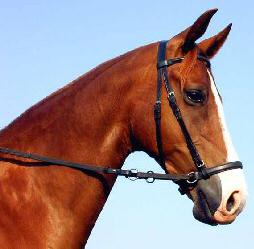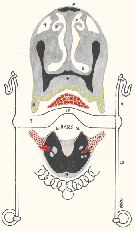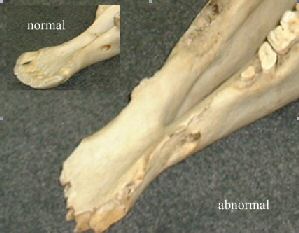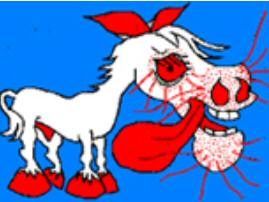The Bitless Bridle™ in UK
Fear of the Bit: A welfare problem for horse and rider
W. Robert Cook FRCVS, PhD
Part I: Why Horses Hate the Bit
- Part II: Bit-induced diseases and other indictments (including 'The Bit as the Cause of the Headshaking Syndrome')
- Part III: Behavioural Profiling Questionnaire
Introduction
Fig 1. Showing how the noseband of the
Bitless
Bridle is fitted low on the head,
yet without obstructing
the nostrils
[Photo courtesy of Carole Iverson]

At Equitana USA, 2000, the Bitless Bridle won the Enterprise Award for "the most innovative new equine tack product" (Fig 1). The award covered the period since 1999 but, realistically, the new bridle is the first major innovation in tack since the curb bit was introduced in the fourth century BC. (Diagram & explanation of Bitless Bridle fitting)
Since 1998, the author has published a good deal about his research into the disadvantages of bits and the advantages of bitlessness. Six articles in scientific journals and a further 10 in horsemen’s journals have compared and contrasted the bit with the bitless method of communication. In addition, independent authors have published a further 27 articles on the bitless method, in horsemen’s journals around the world.
The present article has three objectives. First, to provide a foundation bibliography on the new bitless method. Secondly, to present additional material in a format that can be understood by both veterinarians and non-veterinarians. Thirdly, to publish a questionnaire that enables riders to compile a behavioral profile of their horse when ridden with and without a bit.
The first part of the questionnaire alerts a rider to 105 problems that the bit may be causing their horse and themselves. The second part documents which of these problems the bit was causing. The questionnaire is based on a series of yes/no answers to the presence or absence of 105 adverse behavioral problems that the author now recognizes as being caused by the bit. In the last five years, all these problems, in many different horses and for many different riders, have been eliminated by removal of the bit (Cook 2003). Riders who banished the bit have discovered that they owned a much better horse than they thought. Elimination of bit-induced problems enhanced the welfare and performance of their horse and made riding simpler, safer and more satisfying.
The article is in three parts, reflecting the three objectives.
An update on recent research
Man has underestimated the harmful effect of placing one or more metal rods in a horse’s mouth (Cook 1998a, 1998b, 1999a, 1999b, 1999c, 2000, 2001a, 2001b, 2002a, 2002b, 2002c, and 2003) [The texts of the full references are available at www.bitlessbridle.com. A complete reference list of all the articles that have been published about the new bridle is also available online]. Though all horsemen are familiar with the phrase 'aversion to the bit', if they were asked to compile a list of the problems that make up this syndrome they would probably have difficulty in thinking of more than half a dozen.
Yet the author recognizes 95 problems that affect the horse and at least 10 more that affect the rider. It has only been possible to recognize this number since the recent development of a bitless bridle that differs entirely in concept from the traditional hackamores, bosals and sidepulls. The ease with which a horse can be switched, overnight, from its regular bit to the new bitless bridle has served to highlight many problems that had not previously been recognized as being caused by the bit. Essentially, this has constituted an unprecedented opportunity to conduct a large-scale controlled experiment.
Recently, the author surveyed the written reports he had received from 605 users of the new method (Cook 2003). Since then, the survey work has continued and the questionnaire in Part III of this article is based on the updated findings. The comparison of behavior has been that between a painful and invasive method of communication (the bit), and a painless and non-invasive method (the Bitless Bridle) [The bit method is invasive in the sense that it involves inserting one or more a foreign bodies into a body cavity]. As the behavior of their horses when bitted had been familiar to most riders for several years, and as the switch from bitted to bitless communication was literally overnight, the before-and-after behavior patterns were strikingly contrasted. Ten major findings that have emerged from this research are listed below:
- A bit (any bit) causes a horse pain, whether or not the rider is aware of the fact
- Pain, and other pathophysiological contradictions generate behavioral problems in the horse that are more common and more serious than have previously been supposed
- Manifestations of pain caused by the bit can be classified under the four F’s of fright, flight, fight and facial neuralgia
- All of the above are subsets of FEAR, and all increase the likelihood of accidents to both horse and rider
- The bit is a common cause of asphyxia (‘thickness of wind,’ ‘roaring,’ and ‘choking-up’) and should routinely be considered as a differential diagnosis for recurrent laryngeal neuropathy (laryngeal hemiplegia)
- The bit is a common cause of several diseases for which the cause has previously been listed as unknown (e.g. the headshaking syndrome, dorsal displacement of the soft palate, epiglottal entrapment, collapse of the windpipe, and pulmonary bleeding)
- The bit is a common cause of poor action, stumbling, and shortened stride and, because it reduces the supply of oxygen, results in premature fatigue, breakdowns, falls and limb bone fractures
- Removal of the bit benefits not only those horses that riders recognize as ‘hating the bit’ but also those in which the rider has never recognized any such aversion
- Removal of the bit makes riding safer, simpler and more satisfying for the rider
- Removal of the bit enhances performance, reduces accidents and advances the welfare of the horse
A review of communication methods
Stone Age man, about five thousand years ago, deserves the credit for having first domesticated the horse. Unfortunately, at the same time he made the understandable mistake of inventing the bit. The presence of what appeared to be a convenient gap between the teeth tempted early man to make use of it as a means of getting a handle on the beast. [The proximity of the root of the canine tooth to the bars of the mouth in the male horse and the possible presence of unerupted wolf teeth in both sexes was of course unknown.]
Early bits were probably made of plaited rawhide, wood, bone, and horn, but metal was quickly adopted as the norm. Sadly, the bit method of communication has survived through the Bronze Age, the Iron Age, and into the age of stainless steel. The simple bar snaffle has been followed by the jointed snaffle and design has become more ingenious with the curb and chain bit. As one bit has often been considered insufficient, two bits are frequently used, as in the double bridle and other examples. Leverage bits (i.e. curb bits) logarithmically increase in the mouth whatever pressure the rider applies to the reins. The pressure is applied to the jawbone at the bars of the mouth (Fig 2).
Fig 2. Showing a cross-section
through a horse’s head,
level with the corner
of the mouth, with a
curb bit in position
(click for full-size image & key)

The diagram is drawn to scale and the section is viewed as though the reader is standing in front of the horse, looking directly into its mouth. The diagram is based on measurements taken from the skull of a larger than average horse, yet the bars of the mouth are only 29 mm (1 1/8 th inch) apart. For illustrative purposes, the shank of the bit is shown at 90° to the line of the lips. In practice, it should never achieve more than a 45° angle but this discrepancy does not affect the principles of action discussed below.
The curb bit illustrated has a 10 cm (four-inch) mouthpiece, 12.5 mm (half-inch) diameter cannons, a mild port, and a two-to-one ratio between a 5 cm (two inch) cheek bar and a 10 cm (four inch) shank. As curb bits go, this is regarded as a mild curb. The mouth is illustrated in a slightly open position, with the lips just parted. In a double bridle, the bradoon bit would lie on the bars above the curb and between it and the first molar tooth. For the sake of clarity, an air space is shown between the curb bit and the bars of the mouth but in use these would be in contact whenever the tongue is either behind or above the bit. Nevertheless, the bit does allow air into the mouth and so it is appropriate, though regrettable, to show air around the tongue and other places.
The tip of the tongue is shown ‘above the bit.’ This is probably the least painful position for that delicate sense organ. A horse has two other options. The first is to leave it under the bit. As the tongue is wider than the bars, this will be more painful, for the tongue will be trapped between the bit and the sharp edges of bone that constitute the bars. The second is to withdraw the tongue so that its tip comes to lie ‘behind the bit.’ This avoids tongue pain but causes the same bone ache as when the tongue is ‘over the bit.’ In addition, the root of the tongue now elevates the soft palate and this, together with the ingress of air in to the digestive part of the throat, obstructs the respiratory part of the throat.
When the curb is centrally placed in the mouth, the port would prevent the cannons of the bit pressing directly down on the knife-edges of the bars. Instead, the cannons would tend to clamp and compress the jaw in a side-to-middle direction. In so doing they would pinch the terminal branches of the mandibular nerve as it exits the jaw at the mental foramen (Fig 2 and see also Part II; Fig 1). At any time when the curb is not symmetrically placed in the mouth, one cannon would act like a seesaw on one knife-edge bar.
A snaffle or a curb bit is a pressuring device that generates pain or the threat of pain by the application of metal on bone. The bone is thinly covered with gum but has no other ‘cushion.’ At the level of bit pressure the bone is roughly circular in cross-section with a pie-section missing that produces two sharp edges at 11 o’clock and 1 o’clock, the bars of the mouth. In a large horse, such as the one depicted here, the diameter of the section is 45 mm; the same diameter as a standard hen’s egg when cut in half. The bone is also as fragile as the simile suggests and should be treated with the same respect.
As the bit applies pressure to the top edge of the lower jaw (the bars of the mouth) and the curb chain applies pressure to the bottom edge, the bone and soft tissues are being clamped between two pieces of steel. The bars of the mouth are two knife-edges of bone, covered with only a thin layer of gum and the mucosa of the mouth.
What we call ‘gum’ consists of a layer of fibrous tissue, about 2 mm thick, that is firmly attached to both the underlying bone and the transparently thin mucous membrane of the mouth. It is, in reality, modified periosteum (‘skin of the bone’). Therefore, any damage to gum is damage to bone. [As bone relies on its periosteum for its nutrition, damage to the gum (periostitis) can result in sections of the bone dying and forming what are known as sequestra. These pieces of dead bone, some as long as 3.0 cm, now have to be sloughed away from the surrounding tissue or be surgically removed.]
The bars are not flat as often described and neither are they ever sufficiently padded with soft tissue to justify the description of being ‘rounded and fleshy’ (Fig 2). At the bars, the bone of the jaw is not cushioned or in any way protected from the bit. It is as exposed to injury as the human shin. The tip of the tongue may or may not provide some cushioning. Because a horse frequently and deliberately retracts its tongue behind the bit (and in so doing obstructs its own breathing), the tongue cannot be looked upon as a protection for the bone. [ Place a pencil in your mouth and note how you immediately retract your tongue and use its tip to incessantly ‘play’ with the pencil. Now discover how difficult it is to drink or eat. Try not to slobber.]
When the bit presses on the bars, the pounds per square inch pressure (psi) being concentrated on their knife-edges must be immense. Not surprisingly, this pressure frequently damages the bone and results in the growth of painful bone spurs [The actual pressure has yet to be measured but let us take a hypothetical example. Suppose that a rider applies 5 lbs. of pressure to the curb rein, a figure that is not uncommon according to work done by Dr. Hilary Clayton at Michigan University. Let us assume that the curb bit has a shank of a length that multiplies this pressure by three. Accordingly, 15 lbs. of pressure will be distributed over a surface area of about 1/5th of a square inch of bone. This would translate to a pressure of 75 psi. Imagine what the psi might be if a horse spooks and a rider momentarily snatches at the reins to regain balance. The rider’s full weight and momentum banging against the bars of the mouth must generate a tremendous force.] (Fig 3)
Fig 3. Showing the smooth profile of the bars on the
right side
of a normal horse (inset)
for comparison
with a large bone spur
on the same side of the other jaw
.
The abnormal jaw also has a bone spur on its left side, though it is less easy to see. All bone spurs are located, as these are, on the bars immediately above the hole (the mental foramen) on the side of the jaw from which the mandibular nerve emerges (Fig 2 and see also Part II; Fig 1). The bars of the mouth on the abnormal jaw were 32 mm (1 1/4 inch) apart at the level of the bone spur. The mouthpiece of a bit would pivot like a seesaw on the knife-edges to produce these lesions.
The author’s survey of 65 jawbones from horses five years old or older in three museum collections (Cook 2002a) has shown that bone spurs were present in 49 (75%). As some of the 65 horses were feral horses and had been bit-free all their lives (the feral horses had no bone spurs) the real incidence of the problem in the bitted horses was actually greater than 75%. No bone spurs were found in a survey of 35 zebra skulls. Readers can readily imagine how excruciatingly painful it must be for a horse with bone spurs on the bars of its mouth to be ‘controlled’ by a steel bit. No wonder that they toss their heads, open their mouths and ‘evade the bit’ in endless different ways.
Sadly, instead of treating a problem by removing its cause, which is the only valid approach to treatment, the standard approach to these evasions is to employ a variety of supplementary devices aimed at suppressing the symptoms. These devices are designed to prevent a horse from doing those things that it would never think of doing if it did not have a bit in its mouth in the first instance. Hence the use of ingenious straps to try and close the mouth, such as dropped nosebands, flash and grackle nosebands. Similarly, in the hope of limiting if not preventing head tossing, standing and running martingales are employed. To discourage evasion of the bit by tongue movement, racehorses have their tongues tied to their lower jaws with either rigid or elastic straps. Predictably, none of these measures are effective cures for the problem. They are not even very effective in suppressing the symptoms.
Further indictment of the bit method of communication will be found in Parts II and III of this article. For the present, it suffices to note that the antiquity of a method is no assurance of its true fitness of purpose. The bit method’s primary fault is that, except in the hands of a master horseman with an unshakably independent seat, the bit causes pain (Cook 2003). ‘Good hands’ depends on having little or no pressure on the bit. As the horse’s mouth is one of the most sensitive parts of its anatomy, even the slightest pressure causes intense pain (Fig 4). [The guiding principle for good saddle fit is that no pressure should be applied to bony prominences such as the withers and spine. The saddle should not even touch these areas. Instead, pressure should be well and evenly distributed over the fleshy part of the back, i.e. the muscles. Sadly, until the last six years, the same guiding principles have not been applied to the bridle. The principle behind all bits, hackamores, bosals and sidepulls directly contravenes this ‘no pain’ guideline. Pressure is deliberately placed on bone and is, therefore, painful. The Bitless Bridle, on the other hand, follows the guiding principles for saddles and indeed saddlery in general, that it should be incapable of causing pain. The new bridle can only apply a rather trivial pressure and what pressure is applied is distributed around the whole of the head, much of it on fleshy areas such as the cheeks and poll.]
Fig 4 - This is what a horse looks like if one apportions scale and color to represent the relative sensitivity to touch of its various parts. The red areas represent those areas that are most generously supplied with sensory nerves. In such a representation the muzzle and mouth become the largest parts because these are the most ‘touchy/feely’ areas. The horse depends on its muzzle to feel its way around the world.
The horse exhibits this pain through the four F’s of fright, flight, fight and facial neuralgia (the headshaking syndrome). Apart from these being the underlying cause of accidents to horse and rider, the bit also interferes with both breathing and striding (Cook 1999a, 1999b, 2000). Shortage of breath is a cause of premature fatigue and, once again, fatigue is a potent source of accidents. Fatigue causes falls and falls can be fatal to man and horse. Finally, fatigue is a common cause of poor performance.
Criteria for an acceptable method of communication
The three indispensable requirements are that it should be:
- Humane
- Effective as a form of communication
- Compatible with the physiology of the exercising horse
The bit method of communication is unacceptable on all three criteria. It might be considered humane in the hands of a master horseman who has learned to avoid its use. But even master horsemen are not born with good hands and so horses will undergo years of pain before a budding master achieves years of discretion. In the hands of an average horseman, a bit is a painful method. In the hands of a novice, a bit method is clearly cruel.
A fourth preference for any form of communication is not an absolute requirement but it adds to the merit of the method. This is the applicability of the method for all types, temperaments, ages and uses of the horse, together with all types, temperaments, ages and skills of the rider. Though the bit method has long been used for all disciplines and on all types of horse, it has to be said that the bit lends itself far too easily to abuse, both intentionally and unintentionally. It cannot, therefore, be recommended for universal application (see Part II: Table I). [The problems caused by the bit and the principles of communication discussed in this article are based on six year’s experience of the whole-head-hug (Bitless Bridle) option for riding. The author believes that the same problems and principles apply also to driving but he does not as yet have the same feedback from this discipline. He is currently gathering test-driving evidence and will report on these findings in due course.]
Quite apart from the evidence now accumulated that the bit causes pain, the effectiveness of the bit method from the rider’s point of view can be shown to be questionable, simply by noting the multiplicity of bit designs that are on the market. The situation is rather similar to the situation in medicine. Whenever there is a multiplicity of treatments for any one disease or problem it is generally true to say that none of them is entirely satisfactory. Unsurprisingly, the bit method is ineffective in preventing the many bit-induced instances of bolting, bucking and rearing. When it is recognized that all three of these problems are commonly caused by the bit, it becomes apparent that it is illogical to expect such problems to be cured by continuing to use the same method and simply changing the design of the bit.
Copyright © 2004-2025 Bitless Bridle UK All Rights Reserved | The Bitless Bridle™ is protected by US patent 6591589
Website designed, maintained and hosted by Flashgranny

